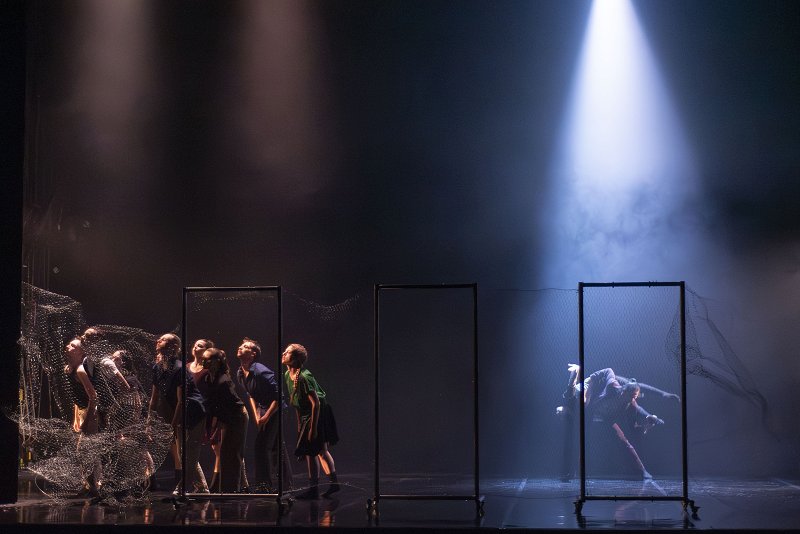The dance diptych Border-Line, choreographed by Michal Rynia and Nastja Bremec Rynia and Igor Kirov, thematises the concept of borders around us and within us. The dance performance naturally uses movement as its language, which is, to paraphrase Karima Mansour, our common language, a universal language that belongs to everyone. "Dance is where culture is shared, where borders merge into a space of inclusion and unity through the unspoken language of universality."
BORDER
The first part, "Border", choreographed by Igor Kirov, is about the universal problem of political and economic division of territory, one of the main motives for human conflicts and wars, and on the other hand about the imposition of borders on the population along borders and on the territories of countries. It tells about the history, the present and the future of the fences and borders that restrict human freedom, and questions the challenges of mental borders and human rights in contemporary times. Throughout human history, the fates of people, young loves, families, plans and dreams have been fractured and intertwined along barbed wire, iron curtains. Families where grandparents could not see their grandchildren grow up, parents and children who did not know each other or were still alive, couples in love whose fates may have been forever separated, the living and the dead, were intersected... Today, at a time of new reasons for closing borders, the reflection on the freedom of movement of human beings is particularly topical.
Manifest - manifesto for a better world, a world without borders, which aims to transform society and our relationships with each other. A manifesto that builds a world where everyone has the freedom to move and live. A manifesto for a better, shared tomorrow. Conceptual design by Mojca Majcen. Text based on Charlie Chaplin's text from The Great Dictator Choreography and performance by Daša Grgič.
LINE
The second part, "Line", choreographed by Nastja Bremec Rynia and Michal Rynia, deals with the boundaries within ourselves, which go beyond the physical, mental and emotional, and come from external and internal sources. From social and cultural expectations and interpersonal dynamics, from our thoughts, fears, insecurities and past experiences, and manifest themselves as self-imposed limitations that hinder our personal growth and fulfilment. On the other hand, transcending these boundaries increases our resilience and freedom to embody our true self. The boundary between the dualities within us represents a delicate balance between the opposing forces that exist within each of us. It is a threshold that reflects the complexity and interconnectedness of our nature. The boundary between good and evil, light and dark, free and unfree, embodies the eternal struggle between the conflicting aspects of our personality and the world around us. It highlights the grey areas where moral ambiguity, inner conflicts and contradictions coexist and shape our perceptions and actions. Navigating these boundaries requires introspection, empathy and a deep understanding of the complexity of human nature. Accepting the interplay of duality and difference can lead to greater self-awareness, acceptance of our shadows and a more nuanced appreciation of the richness and depth of our experiences.

The dance diptych Border-Line / a dance performance
part 1
Border
Choreography by Igor Kirov, Music by Henryk Górecki: Symphony No.3 , Op. 36 (Symphony of Sorrowful Songs) I. Lento- Sostenuto tranquillo ma cantabile ,Costume design by Anka Rener Kremžar, Scenography by PDNBN Works - Urh Ručigaj Roberts, Set design by Maša Mazi s.p, Lighting design by Matjaž Bajc
Dancers Eri Nishibara, Luka Vodopivec, Pietro Di Salvo, Alessio Saccheri, Iva Ilievska, Rebecca Granzotto, Marie da Silva, Paula Garcia, Erica Modotti, Luca Marchi, Michal Rynia, Mojca Majcen and Nastja Bremec Rynia
Duration: 27 minutes
Intermezzo
Manifest
Conceptual design by Mojca Majcen, Text: based on Charlie Chaplin's text from The Great Dictator, Choreography and performance by Daša Grgič, Interpretation of the text by Nikla Petruška Panizon
part 2
LINE
Choreography, costume and set design by Nastja Bremec Rynia and Michal Rynia, Lighting design by Matjaž Bajc
Dancers Eri Nishibara, Luka Vodopivec, Pietro Di Salvo, Alessio Saccheri, Iva Ilievska, Rebecca Granzotto, Marie da Silva, Paula Garcia, Erica Modotti, Michal Rynia and Nastja Bremec Rynia
Duration: 30 minutes
Production: MN Dance Company, Balkan Dance Project (as part of Mojca Majcen's oeuvre), Festival Velenje, Dance Project Trieste, GO! 2025 - European Capital of Culture
Co-production: Zavod Celeia Celje, SLG Celje S
The performance is part of the EPK GO! 2025' project Borderless Body
The project is co-financed by GO! 2025 - European Capital of Culture Nova Gorica - Gorizia, Ministry of Culture R Slovenia and Municipality of Nova Gorica.